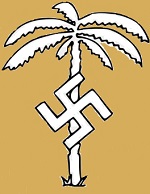Hobby Master HG3903 German Opel Blitz 3-Ton Cargo Truck - 21.Panzer Division, Deutsches Afrika Korps, North Africa, 1942 (1:72 Scale)
"The peril of the hour moved the British to tremendous exertions, just as always in a moment of extreme danger things can be done which had previously been thought impossible. Mortal danger is an effective antidote for fixed ideas."
- Generalfeldmarschal Erwin Rommel
 In 1929, GM acquired the engine producer Adam Opel AG, based in Russelsheim, Germany, and with it, one of the most well regarded manufacturing plants in Europe. In the early 1930's, Opel introduced a fast light truck, calling it the Opel Blitz (Lightning) and in 1935 opened a modern truck factory in Brandenburg. Although light in weight, the Blitz design could carry a considerable payload. A proven six-cylinder engine from another GM company, Buick, provided the power. The payload increased in steps from the original 1.93 tons to 2.76 tons, and finally to 3.31 tons, of which the S type could transport cross-country.
In 1929, GM acquired the engine producer Adam Opel AG, based in Russelsheim, Germany, and with it, one of the most well regarded manufacturing plants in Europe. In the early 1930's, Opel introduced a fast light truck, calling it the Opel Blitz (Lightning) and in 1935 opened a modern truck factory in Brandenburg. Although light in weight, the Blitz design could carry a considerable payload. A proven six-cylinder engine from another GM company, Buick, provided the power. The payload increased in steps from the original 1.93 tons to 2.76 tons, and finally to 3.31 tons, of which the S type could transport cross-country.
The greatest production figures were achieved by the Opel Blitz 3-ton S with 82,356 units produced with the 3.6 liter engine from April 1937 to the beginning of August 1944. This dependable, light 3-ton truck enjoyed great popularity among the units. The simple, yet robust Opel design proved itself in the confusion of war and was superior to many specially-designed vehicles. The 3-ton Blitz was superior to many other 3-ton trucks on account of its low ground pressure which was a result of the vehicle's low weight.
Pictured here is a 1:72 scale replica of a German Opel Blitz 3-Ton truck which was attached to the 21.Panzer Division, then deployed to North Africa during 1942.
Sold Out!
Dimensions:
Length: 3-1/4-inches
Width: 1-1/4-inches
Release Date: October 2009
 Historical Account: "With the Fox" - The Afrika Korps was formed on February 19th, 1941, after the German Armed Forces High Command (OKW) had decided to send an expeditionary force to Libya to support the Italian army, which had been routed by an Allied counteroffensive, Operation Compass. The German expeditionary force, commanded by Erwin Rommel, at first consisted only of the 5.Panzer-Regiment and various other small units. These elements were organized into the 5.Leicht-Division when they arrived in Africa in February.
Historical Account: "With the Fox" - The Afrika Korps was formed on February 19th, 1941, after the German Armed Forces High Command (OKW) had decided to send an expeditionary force to Libya to support the Italian army, which had been routed by an Allied counteroffensive, Operation Compass. The German expeditionary force, commanded by Erwin Rommel, at first consisted only of the 5.Panzer-Regiment and various other small units. These elements were organized into the 5.Leicht-Division when they arrived in Africa in February.
In the spring, the 5.Leicht-Division was joined by the 15.Panzer Division, though it did not arrive until Rommel had already re-taken most of Cyrenaica and gone back over to the defensive. At this time the
Afrika Korps consisted of the two divisions plus various smaller supporting units, and was officially subordinated to the Italian chain of command in Africa (though Rommel had conducted his offensive without any authorization).
On October 1st, 1941, the 5.Leicht-Division was redesignated as the 21.Panzer Division, although it was still attached to the
Afrika Korps. During the summer of 1941, the OKW invested more command structure in Africa by creating a new headquarters called Panzer Gruppe Afrika. On August 15th, Panzer Gruppe Afrika was formally activated with Rommel in charge, and command of the Afrika Korps was turned over to Ludwig Cruewell. The Panzer Gruppe controlled the Afrika Korps plus some additional German units that were sent to Africa, as well as two corps of Italian units. (A German "group" was approximately the equivalent of an army in other militaries, and in fact Panzer Gruppe Afrika was redesignated as Panzer Armee Afrika on January 30th, 1942.)


